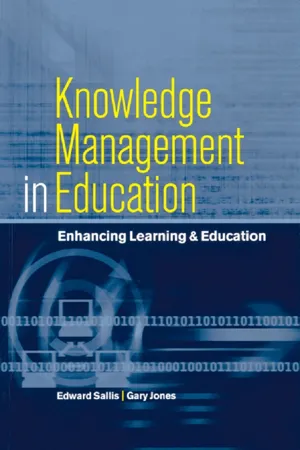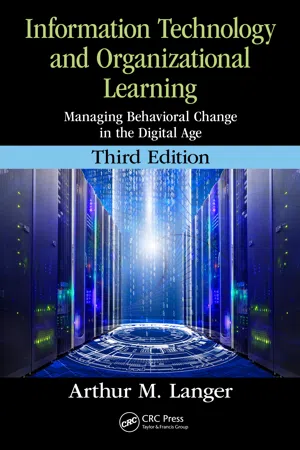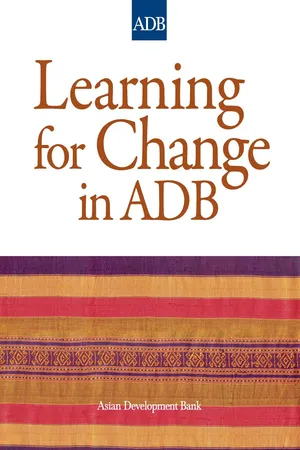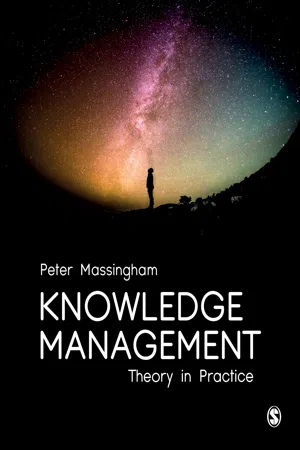Business
Learning Organization
A learning organization is one that encourages and facilitates continuous learning and development among its employees. It promotes a culture of knowledge sharing, innovation, and adaptability, allowing the organization to quickly respond to changes and challenges in the business environment. This approach fosters a more agile and competitive business, as well as a more engaged and empowered workforce.
Written by Perlego with AI-assistance
Related key terms
5 Key excerpts on "Learning Organization"
- eBook - ePub
Knowledge Management in Education
Enhancing Learning & Education
- Edward Sallis, Gary Jones(Authors)
- 2013(Publication Date)
- Routledge(Publisher)
5 Learning Organizations‘The rate at which organizations learn may become the only sustainable source of competitive advantage.’Peter SengeChanges in information and communication technologies are having a profound effect on society and on the life of the people within it. Organizations need to build a culture of learning that allows for continuous knowledge creation and transformation. They need to understand how they create knowledge – that is to say, how they learn. This chapter concentrates on some of the key aspects of organizational learning and the links between learning, knowledge and creativity, and some of the techniques that can be employed to develop Learning Organizations.Knowledge management and Learning OrganizationsThe concept of the Learning Organization is parallel to the concept of knowledge management. They are linked by the need to sustain a competitive advantage in a highly competitive world, by being able to innovate and adapt. Building a Learning Organization can be one of the most important activities for long-term organizational improvement and flexibility. The knowledge management gurus almost universally put enormous emphasis on the power of learning. Dorothy Leonard, for example, has argued that knowledge-based organizations are those that are enthusiastic about learning. They are continually learning and are consciously applying the results of that learning to their business. A learning culture is a key component for ensuring that an organization can benefit from the knowledge at its disposal.John Burgoyne has also demonstrated the strong links between knowledge management and the Learning Organization. According to him, ‘True knowledge management is about understanding and improving the way things work, how the different forms of knowledge can be linked, fed by organizational learning and used in adding value to goods and services’ (1999). In arguing that tacit knowledge needs to be made explicit, Ikujiro Nonaka demonstrates that one major means of doing this is to ensure that a learning culture is established. - eBook - ePub
Information Technology and Organizational Learning
Managing Behavioral Change in the Digital Age
- Arthur M. Langer(Author)
- 2017(Publication Date)
- CRC Press(Publisher)
Learning Organization is defined as a form of organization that enables, in an active sense, the learning of its members in such a way that it creates positive outcomes, such as innovation, efficiency, improved alignment with the environment, and competitive advantage. As such, a Learning Organization is one that acquires knowledge from within. Its evolution, then, is primarily driven by itself without the need for interference from outside forces. In this sense, it is a self-perpetuating and self-evolving system of individual and organizational transformations integrated into the daily processes of the organization. It should be, in effect, a part of normal organizational behavior. The focus of organizational learning is not so much on the process of learning but more on the conditions that allow successful outcomes to flourish. Learning Organization literature draws from organizational learning theory, particularly as it relates to interventions based on outcomes. This provides an alternative to social approaches.In reviewing these descriptions of what a Learning Organization does, and why it is important, we can begin to see that technology may be one of the few agents that can actually show what Learning Organizations purport to do. Indeed, Ravell created an evolving population that became capable of dealing with environmental changes brought on by technological innovation. The adaptation of these changes created those positive outcomes and improved efficiencies. Without organizational learning, specifically the creation of a Learning Organization, many innovations brought about by technology could produce chaos and instability. Organizations generally tend to suffer from, and spend too much time reflecting on, their past dilemmas. However, given the recent phenomenon of rapid changes in technology, organizations can no longer afford the luxury of claiming that there is simply too much else to do to be constantly worrying about technology. Indeed, Lounamaa and March (1987) state that organizations can no longer support the claim that too-frequent changes will inhibit learning. The fact is that such changes must be taken as evolutionary, and as a part of the daily challenges facing any organization. Because a Learning Organization is one that creates structure and strategies, it is positioned to facilitate the learning of all its members, during the ongoing infiltration of technology-driven agents of change. Boland et al. (1994) show that information systems based on multimedia technologies may enhance the appreciation of diverse interpretations within organizations and, as such, support Learning Organizations. Since Learning Organizations are deliberately created to facilitate the learning of their members, understanding the urgency of technological changes can provide the stimulus to support planned learning. - eBook - ePub
- (Author)
- 2009(Publication Date)
- Asian Development Bank(Publisher)
Building a Learning Organization
The Learning Organization Model
It is not the strongest of the species who survive, nor the most intelligent; rather it is those most responsive to change. —Charles DarwinFor organizations wishing to remain relevant and thrive, learning better and faster is critically important. Many organizations apply quick and easy fixes often driven by technology. Most are futile attempts to create organizational change. However, organizational learning is neither possible nor sustainable without understanding what drives it. Figure 10 shows the subsystems of a Learning Organization: organization, people, knowledge, and technology. Each subsystem supports the others in magnifying the learning as it permeates across the system.Figure 10 : Building a Learning OrganizationSource: Author.Organization
A Learning Organization values the role that learning can play in the development of organizational effectiveness. It demonstrates this by having an inspiring vision for learning and a learning strategy that will support the organization in achieving its vision.The supreme accomplishment is to blur the line between work and play. —Arnold ToynbeeThe leadership of a Learning Organization is committed to the importance of learning and clearly communicates that learning is critical to organizational success. The leadership recognizes the importance of providing the motive, means, and opportunity for learning: (i) the motive being the “why?”— the purpose and reason for learning; (ii) the means being the “how and what?”—the models, methods, and competencies required; and (iii) the opportunity being the “where and when?”—the spaces for learning. Leaders take an exemplary leading role in creating and sustaining a supportive learning culture. - eBook - ePub
Knowledge Management
Theory in Practice
- Peter Massingham(Author)
- 2019(Publication Date)
- SAGE Publications Ltd(Publisher)
a consciously managed organization with ‘learning’ as a vital component in its values, visions and goals, as well as in its everyday operations and their assessment. The Learning Organization eliminates structural obstacles of learning, creates enabling structures and takes care of assessing its learning and development. It invests in leadership to assist individuals in finding the purpose, in eliminating personal obstacles and in facilitating structures for personal learning and getting feedback and benefits from learning outcomes. (Moilanen, 2001: 11)Similarly, Pedler et al. (1997: 3) define it as an ‘organization which facilitates the learning of all its members and consciously transforms itself and its context’.Senge (1990: 231) defined the Learning Organization as a workplace ‘where people continually expand their capacity to create the results they truly desire, where new and expansive thinking are nurtured, where collective aspirations are set free and where people are continually learning how to learn together’. His use of phrases like ‘people … continually expand their capacity’, ‘new patterns of thinking’, ‘collective aspiration’, and ‘continually learning’ show that Senge’s view of the ideal organization was very much humanistic management. It is an organization that genuinely cares for employees and wants to help them be the best they can.DEEP THINKING: Critics have described Senge’s Learning Organization model as propaganda (e.g. see Coopey, 1998) for two reasons: (a) it is too prescriptive and only valued by consultants and practitioners, and (b) it is naïve in the sense that it relies on the emancipation of employees (humanism) and their self-development (e.g. personal mastery), when the reality is that management seeks to use its power to exploit workers rather than nurture them.This chapter adopts the view that the Learning Organization is aspirational but it still has important value for knowledge management, particularly in terms of how to improve organizational learning. The value in Senge’s model begins with the influence of systems thinking. This led to a focus on behaviours designed to create synergy such as teamwork, collaboration, and cooperation. His model was a perfect fit for organizations wanting to develop effective organizational learning. The model has five disciplines: - eBook - ePub
Understanding College and University Organization
Theories for Effective Policy and Practice
- James L. Bess, Jay R. Dee(Authors)
- 2012(Publication Date)
- Stylus Publishing(Publisher)
Instead, the dialectical learning model offers several ways for organizations to capitalize on instability. In fact, this model suggests the need to embrace the tension between order and disorder. Learning modes such as improvisation, humor, and small wins enable organizations to learn through healthy tensions. But these modes may not be susceptible to dealing with high levels of complexity. Improvisation, humor, and small wins all constitute relatively finite moments in organizational learning.Instead, the postmodern learning model, with its emphasis on fragmentation and critique, may be well suited to addressing both instability and high levels of complexity. The goal of learning in this model is not to find an answer or even arrive at a consensus interpretation; rather, the aim is to foster multiple, diverse interpretations. The maintenance of such diversity may be essential to dealing with the complexity and chaos of organizational life.The Learning Organization
The field of organizational theory increasingly recognizes the critical role that organizational learning plays in creating effective organizations, especially in highly competitive environments. These findings have stimulated a companion field of study on the Learning Organization, which seeks to identify organizational characteristics associated with learning and effectiveness. According to the findings of an empirical study by Kontoghiorghes, Awbrey, and Feurig (2005):the following Learning Organization characteristics were found to be the strongest predictors of rapid change adaptation, quick product or service introduction, and bottom-line organizational performance: open communications and information sharing; risk taking and new idea promotion; and information, facts, time, and resource availability to perform one’s job in a professional manner. (p. 185)These characteristics are most likely to promote the disposition of workers to change quickly and to accept new ideas.Management consultant Peter Senge (1990) popularized the concept of the Learning Organization. Building on the work of Chris Argyris and other theorists, Senge developed five “disciplines” to guide organizational learning. A discipline for Senge is “a body of theory and technique that must be studied and mastered to be put into practice. A discipline is a developmental path for acquiring certain skills or competencies” (p. 10). These disciplines are necessary for all workers to master personally
Learn about this page
Index pages curate the most relevant extracts from our library of academic textbooks. They’ve been created using an in-house natural language model (NLM), each adding context and meaning to key research topics.




